From the June 2021 issue of Apollo. Preview and subscribe here.
Peter Blake has been on the British Art Scene for almost 70 years but has always followed a path of his own. Once when I asked him if he was a Pop artist he unexpectedly answered, ‘Oh yes’. But he was a Pop artist in a way that no others quite were. ‘There were two groups of Pop artists in the mid 1950s,’ he explained. ‘In America in the early ’50s there was Robert Rauschenberg and Jasper Johns who were precursors of Pop art. In this country we had the Independent Group, with Richard Hamilton and Eduardo Paolozzi.’ And then there was Blake, who wasn’t really a member of either.
Blake, who turns 89 this month, is about to open ‘Time Traveller’, an exhibition of work old and new – and also a characteristic blend of both – at Waddington Custot gallery in London (18 June–13 August), with a new monograph Peter Blake: Collage published by Thames & Hudson to coincide with the show. In advance of the opening, we spoke via FaceTime about Blake’s long career, and his delight in collage as a medium.
In the final analysis, perhaps, all great artists are sui generis. But that is clearly the case with Blake. His particular set of interests – among them a lifelong love of folk art and Victoriana, but also of rock ‘n’ roll, Hollywood films and their forgotten stars – belongs to him and nobody else. In aggregate, his artistic skills and favoured media are unique: the ability to create surreal scenes with scissors and glue with a deftness that rivals Max Ernst; an affection for the lost and discarded that brings Kurt Schwitters to mind; and a delicate, lucid painterly touch comparable with that of Euston Road affiliates such as Michael Andrews. Put this all together, add an utterly distinctive vein of fantasy, and you have an artistic sensibility that resists all stylistic categorisation.
In 1962 Blake featured in Ken Russell’s celebrated BBC television documentary Pop Goes the Easel. This film, plus a feature about him in the recently launched Sunday Times Colour Section, turned Blake into a celebrity and one of the first representatives of a new phenomenon: Swinging London. In 1967, in collaboration with his then wife Jann Haworth, he created the cover of the Beatles’ album, Sgt. Pepper’s Lonely Hearts Club Band, still the most identifiable image of that time and place. One might conclude that far from being an idiosyncratic outsider, like some of the ‘folk’ artists whose work he has long collected, Blake himself has been an insider – a famous artist who created perhaps the most famous album cover of all time. In fact, the truth is that he’s always been both insider and outsider. To paraphrase the great jazz alto saxophonist Paul Desmond, ‘I was unfashionable even before it was fashionable to be unfashionable.’ Blake could claim much the same.
His route into the avant-garde of London, such as it was in the early 1950s, was highly unorthodox; indeed, as he tells it, it sounds like a series of random if happy accidents. Born in 1932, Blake comes ‘from Dartford up near the heath’ – from outer London, along the Thames estuary. Having been evacuated and after a miserable few years in rural Essex, Blake failed the eleven-plus exam and didn’t go to grammar school. As a teenager, when he went along for the interview for a technical college, they said, ‘If you want to go to art school there’s one just round the corner, you just have to take a drawing test.’ So he did, and went to Gravesend School of Art. Once there, for a year he did a commercial art course, ‘part of which was that Enid Marx came as visiting lecturer’. He continues: ‘She was the great expert on folk art and popular arts. That was a big influence and inspired my interest. In Gravesend there was an old sea captain who had a collection of figure heads – Gravesend is opposite Tilbury, and whenever the liners went out he would sound the klaxon to wish them well. Marx arranged a visit to the collection.’ Later Blake visited ‘Black Eyes and Lemonade’, the pioneering exhibition of popular art at the Whitechapel Gallery in 1951, and part of the Festival of Britain. But as a teenager, he recalls, ‘I wouldn’t have known what the phrase popular art meant, but I did like fairground painting and I did like boxing booths.’
Blake would become a cultural amphibian, at home in the highbrow world of art schools, where people talked of Cézanne and James Joyce, but enjoying Elvis Presley and fairground stalls, muscle men and tattooed ladies. After Gravesend, he went on to the Royal College of Art, by what he describes as a ‘rather devious course’. ‘I decided I wanted to do painting but was advised to do the commercial art course,’ he says. ‘So when I went to the Royal College I applied as a graphic designer but was accepted as a painter.’ He had put one painting in his portfolio, a portrait of his sister Shirley, and someone must have noticed how good it was.
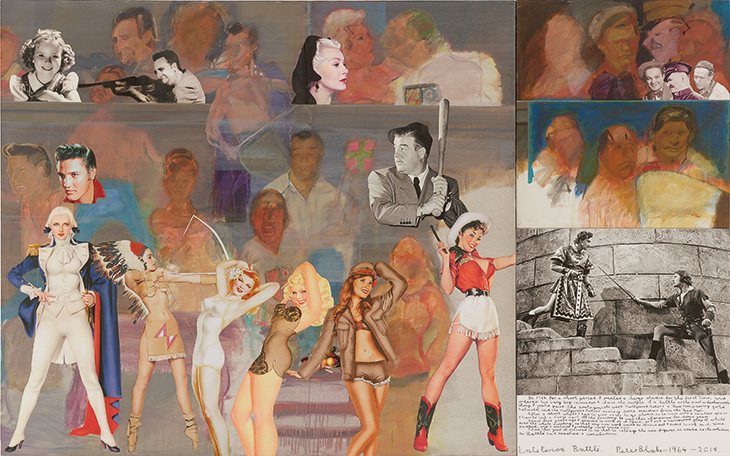
Late Period: Battle (1964–2018), Peter Blake. Courtesy Waddington Custot
At the Royal College his tutors included John Minton, whose name comes up when Blake discusses Late Period: Battle, a painting that he began in 1964. He describes the process of selecting the subject: ‘For a very short period I had a proper studio which I rented. That meant I had room to do a picture on a large scale. So I thought about what the subject should be and decided at that point that something like a battle would be completely unfashionable. No one else would be painting battles in 1964.’
One of the very few artists who had done so relatively recently was Minton: ‘Johnny Minton painted The Death of Nelson [1952] which was a good, big picture which other artists were interested in, but by ’64 if you were trying to do something that nobody else was doing a battle was a good idea.’ This gives two clues to Blake’s motivation: to do ‘something that nobody else was doing’, and being unafraid to revive apparently extinct types of art such as complex, multi-figure compositions.
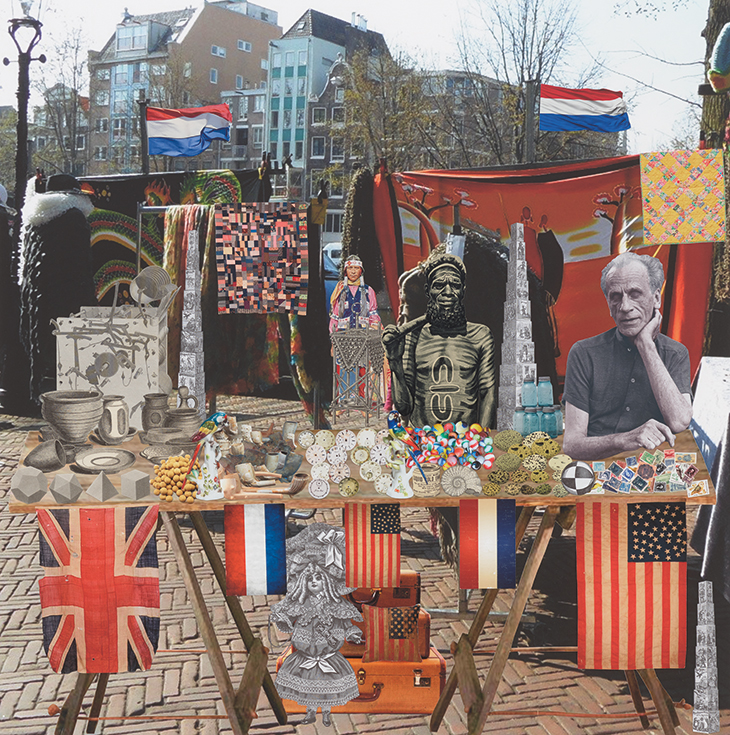
Joseph Cornell’s Holiday – Holland, Amsterdam, Waterlooplein Market. ‘Joseph dreams of a market stall with elements he uses in his work’ (2018), Peter Blake. Courtesy Waddington Custot
In the era of Bacon and Pollock, Minton had made a bold effort to revive the old-fashioned history painting. So, in a very different way, does Blake. Many of the collaged pictures in his recent series, Marcel Duchamp’s World Tour and Joseph Cornell’s Holiday, take the form of complex multi-figure compositions. The difference is that Minton, following the early 19th-century artist, Daniel Maclise, reimagined an actual event from the Napoleonic wars. Blake follows his own unique fantasy, as he did when he conceived Battle: ‘I decided it would be a struggle between good people and bad people. The good people would be made up of Hollywood film stars, and the bad people would be professional wrestlers with golden masks on. And the bad people were trying to steal their women from the good people. That was the story.’
No one else would have come up with the cast of characters in the composition, however. ‘The row of heads in the bottom right-hand corner of the painting at one point was W.C. Fields, Leo Gorcey, “Huntz” Hall and the Bowery Boys, plus Lana Turner.’ Gorcey and Hall are typical Blake figures, once well-known from movies featuring youthful hooligans, but now names that many people would probably need to look up (as I did). Blake points out that they made a return appearance on the Sgt. Pepper cover, or at least Hall did, just above Karl Marx and H.G. Wells (‘Leo Gorcey asked for a fee, so the Beatles took him off’).
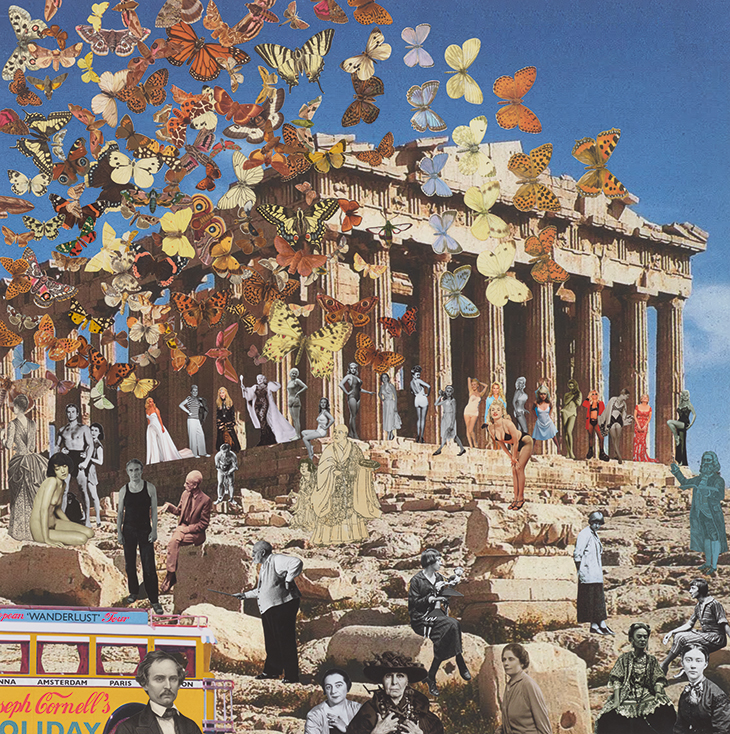
Joseph Cornell’s Holiday – Greece, Athens. ‘The Butterfly Man comes out of retirement to stage a Fly-past for 3 coach parties – Women Artists, Famous Blondes and Joseph Cornell’s Wanderlust Tour’ (2017), Peter Blake. Courtesy Waddington Custot
The cultural mingling in Blake’s recent works is even more eclectic. In one collage, set at the Acropolis in Athens, three coach parties are arriving at the same time. ‘One is Joseph Cornell’s group, which is rather disparate, including Tarzan. Another coach contains women artists – an outing of Frida Kahlo, Pauline Boty and lots of others. The third group is famous blondes, which developed during the making of the collages. It’s headed by Marilyn Monroe and Jayne Mansfield – but as another famous blonde came along, I’d add them to the group, so there’s Blondie and Lady Gaga too.’ This work is part of the series Joseph Cornell’s Holiday, which is dedicated to the great American exponent of collage. ‘Cornell is a great hero of mine,’ Blake says. ‘He loved the idea of travel, but never went anywhere. […] But Cornell was extremely knowledgeable about Europe. The other important aspect was that he never consummated a relationship but loved women. He fell in love constantly. So I thought: he had a pretty rotten time, let’s give him a nice holiday!’
To date, Blake has completed well over a hundred works in this series. Another is set in the Waterlooplein Market, Amsterdam. ‘Cornell’s sitting at a stall with his eyes closed, so he’s clearly asleep, or thinking or dreaming. And on the stall are elements from his work […] and that’s his dream.’ Obviously, Cornell is a surrogate for Blake, himself a master of collage and assembly. It was Blake, not Cornell, who actually visited the Waterlooplein. ‘I had a scholarship in 1956 and travelled to Europe for the first time, and this was the first really marvellous market I’d visited, so it was important to me.’
Markets, like junk shops and fairgrounds, are enchanted hunting-grounds for Blake. Over the years he has put together a vast collection of this and that, housed at his studio in west London, which is partly an extension of, and provides material for, his work and is partly an entity in itself. ‘My collecting is eccentric I think,’ he has admitted, ‘but it’s accountable, I mean I know why I do it, but yes I would have thought I’m quite eccentric. I’m very interested in outsider art and I collect it.’
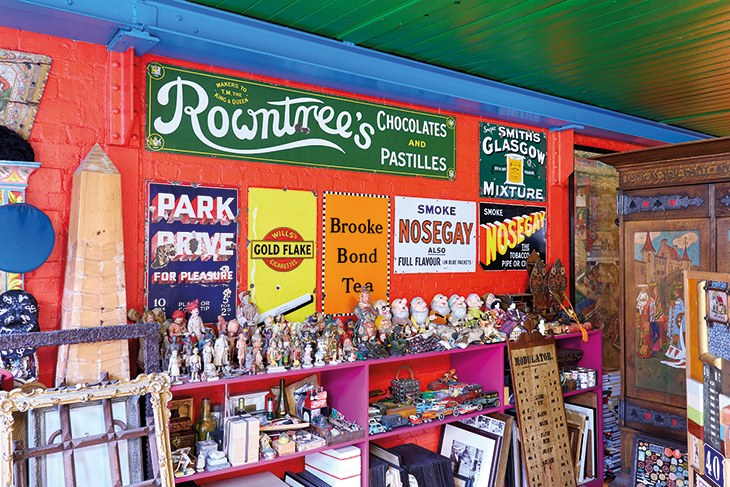
View of Peter Blake’s studio in west London, showing part of the artist’s collection of objects. Photo: Catherine Garcia; © catherinegarciastudio
Like Cornell, Blake is a one-off: a loner within the larger ‘herd of loners’ – to borrow a phrase from Kitaj – who create art. But, as so often with gifted individualists, Blake’s idiosyncrasies are revealing of more than his own personality and imagination. His use of collage is a case in point. Self-Portrait with Badges, a celebrated work from 1961, is a kind of painted collage, including a selection from Blake’s collection of badges, which could have been stuck on to the canvas but are in fact made of pigment. That ambiguity – is it pigment we see or something pasted on to the picture? – exists in many of his works. But not only in his. The more you consider Blake’s multifarious collages, in two and three dimensions, and incorporating everything from lead cowboys to cupboard doors, the more you realise how fundamental the principles of assembly and collage are to art in general.
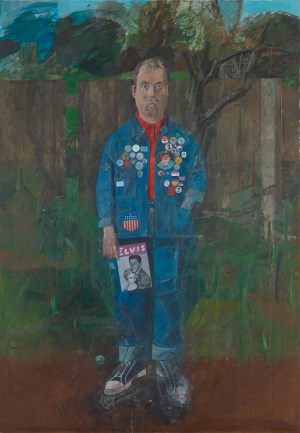
Self-Portrait with Badges (1961), Peter Blake. Tate Collection (on view in ‘Walk Through British Art: 1960’ at Tate Britain, London)
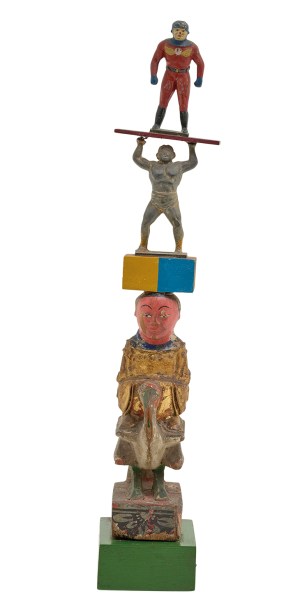
3 Man Up (1961), Peter Blake. Courtesy the artist and Waddington Custot
With hindsight, a great many 19th-century paintings have a vague look of the Sgt. Pepper cover – and that’s no accident. It’s because they were, so to speak, painted collages: created by fitting together a mosaic from photographs and sketches. ‘Pre-Raphaelite paintings look like collage,’ Blake points out, ‘because they are very photographic, aren’t they?’ There is indeed a Pre-Raphaelite aspect to Blake’s career. In 1969, he left London for an old railway station in Somerset and became a founding member of the Brotherhood of Ruralists, a group of urban artists who retreated to the countryside and rejected the ‘new media’ of the ’60s and ’70s in favour of traditional skills such as painting. ‘We’d all come through the ’60s and survived. I’d never done any drugs so with me it wasn’t a matter of physical damage, but people were tired. It felt like the end of something that was going wrong, a party that had gone on too long.’ This was the era of The Good Life; and the Ruralists’ echo of the Pre-Raphaelite Brotherhood was doubtless conscious. Once again, Blake was both against the times and of the moment.
He’s stayed like that. It is true, for example, of his use of media. He has persisted with scissors, glue and paint, but also added 21st-century techniques. ‘I always used to say that you could only make a certain kind of magic in painting. There was no other way of doing it. You could juxtapose certain things that you couldn’t put together by any other method. Now you can. Now a computer does it very well and does exactly what I was trying to do then.’ So, like his old friend David Hockney, in works such as the The Butterfly Man series Blake has taken to digital media. ‘The process in making my recent collages is that I sourced the image that I want to be the background, the scene as it were, usually from old postcards, scanned it, blew it up to the size I wanted it to be, and printed it as an ink-jet.’ He continues: ‘So the background of the collages is a piece of paper with an ink-jet image, sitting at the top. Then I invent the ground, the actual earth. Then collage on top of that. In some of the old postcards you’ve already got a collage, you’ve got images put together. So in the finished work there’s a double element of collage.’
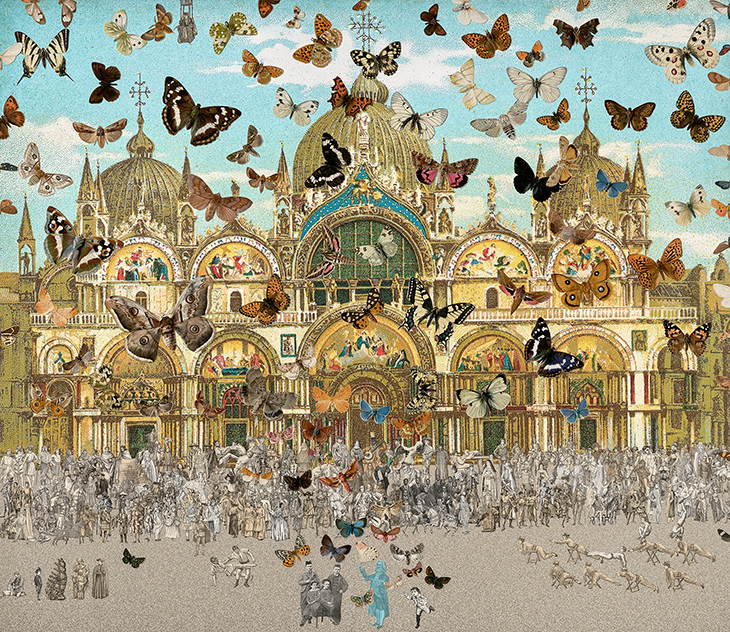
The Butterfly Man – Venice (in homage to Damien Hirst) (2010), Peter Blake. Courtesy Waddington Custot
Indeed, the whole medium is double in a way. There are two collage traditions, and Blake belongs to both: the high-art line of Cubist papier collé and another mode, rooted in a popular Victorian pastime of sticking bits and pieces of cut-out imagery together. It is the latter strand to which Dadaist and Surrealist collages are connected, because as Blake puts it, for them the medium is a means of generating, ‘dreams, stories, and impossible situations’. Blake loves those. He relates with glee how, in his Marcel Duchamp’s World Tour series, ‘Marcel Duchamp meets Elvis Presley and the Spice Girls […] you could only tell that kind of non-possible story in art.’ This is of course a funny idea, as well as one that makes you ponder just what Elvis and Marcel might have had in common.
It’s the same with Blake’s habit of working on, and exhibiting unfinished pictures over long periods of time. It makes you reflect on art in general. True, other painters put things aside, then pick them up years later – though the 54 years of Battle’s evolution must be a bit of an art-historical record. But Blake is also making a comment on the much-discussed subject of what it means to finish a picture. Blake isn’t usually thought of as a conceptual artist, but there are many ways to be ‘conceptual’, of course. The story of the Battle’s first showing, in a group exhibition at the Hayward Gallery in 1977, brings this out: ‘Everybody got a separate booth. I was between Michael Craig-Martin, who was showing the glass of water – “Is this an oak tree?” – and Barry Flanagan, who was showing his early sack pieces: incredibly inventive conceptual pieces. I thought, well I’ll try and fit in here. So I showed a group of paintings including Battle, then I added ten garments, hung in a row, from my collection of clothes: a pearly king’s suit, and I think an Indian robe. It was my attempt at conceptualism, but nobody noticed.’
That was typical of Blake: side by side with other more fashionable artists, keeping pace, parallel to but not quite in the mainstream. But, of course, it’s not true that no one has noticed. The more time goes on, the more notable his achievement seems. ‘At the moment,’ Blake says of Battle, ‘I’m trying to finish things off generally.’ But he’s also carrying on, just as he has for the last seven decades, following his own idiosyncratic path and inviting us all along on his magical mystery tour.
‘Peter Blake: Time Traveller’ is at Waddington Custot, London, until 13 August.
From the June 2021 issue of Apollo. Preview and subscribe here.
Unlimited access from just $16 every 3 months
Subscribe to get unlimited and exclusive access to the top art stories, interviews and exhibition reviews.

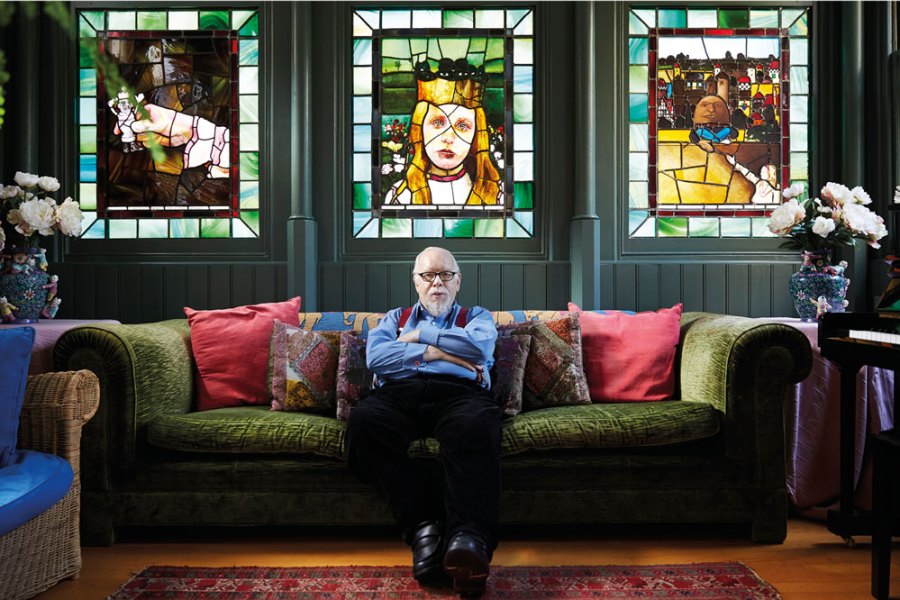
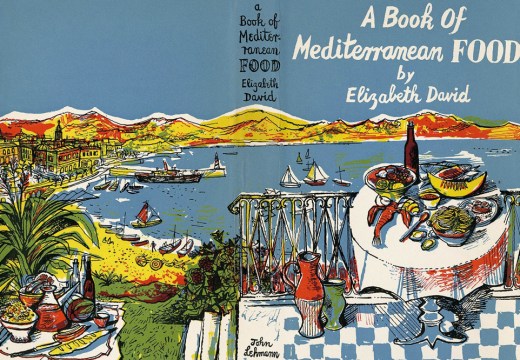

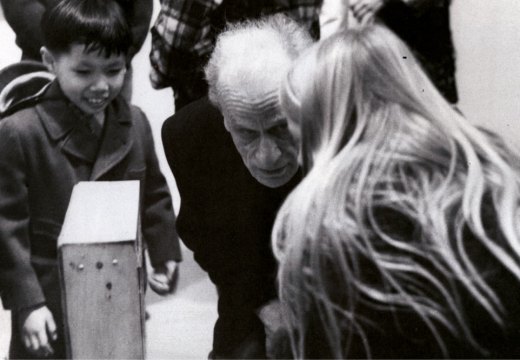









![Masterpiece [Re]discovery 2022. Photo: Ben Fisher Photography, courtesy of Masterpiece London](http://www.apollo-magazine.com/wp-content/uploads/2022/07/MPL2022_4263.jpg)
It’s time for the government of London to return to its rightful home